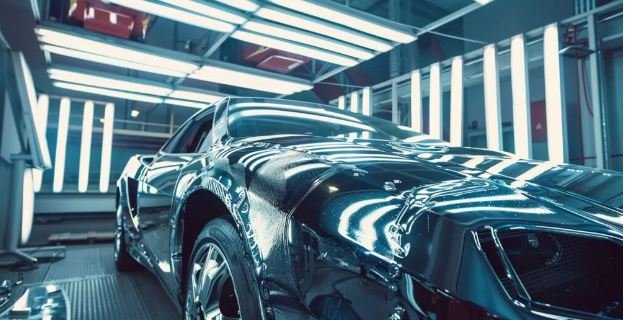The color meter is a valuable tool for learning about the external history of your car.
Did you know that a car’s painted history can reveal a wealth of information about its past, including accidents, repairs and potential problems? Understanding the evolution and importance of car paint will help you make better decisions when buying or maintaining a car, preserving its value and appearance. Immerse yourself in the fascinating world of car painted history and discover the secrets hidden beneath these shiny surfaces.
Short summary
Car paint has evolved from a combination of linseed oil and pigments to modern colors.
The thickness of the paint is an important factor in the car’s value, condition and history.
Knowing the vehicle’s paint history is critical for used car buyers and sellers to make informed decisions about its market value.
Development of car paint
The history of car paint goes back to the beginning of the car industry. Each step in its development contributed to the durability and appearance of today’s vehicles. But what were the first varieties of automotive paint, and how did they change to become the contemporary coatings we use today?
Early car paints were made from a combination of linseed oil and pigment and applied to cars.
Early lacquers and enamels
Lacquers and enamels were the pioneers of car painting. They gave a glossy finish but required multiple coats and long drying times. Lacquer was used during the Jon period around 7000 BC. It originated in Japan in the 19th century BC, and enamel paints introduced in the automotive industry in the 1930s served as the basis for the development of more advanced coatings.
Although not as common today, lacquers and enamels are still used in specialty painting and restoration projects because of their classic look and shine.
Polyurethane paints and clear coats
The introduction of polyurethane paints and clear coats revolutionized automotive painting, offering improved durability, UV protection and resistance to environmental damage. These modern technologies arose from the discovery of polyurethane chemistry in 1937 by Dr. Out. Otto Bayer and his colleagues in Germany developed it and made it commercially available in the 1950s.
Today, polyurethane paints and clear coats are the standard in automotive painting, ensuring that our vehicles not only look good, but also stand the test of time.
The painting process: from KTL to clear coat
Car painting is a complex, multistep process aimed at ensuring a durable and visually appealing finish. It all starts with E-coating, a protective layer applied to a metal surface to protect it from corrosion and other environmental damage. Solvent evaporation plays a critical role in ensuring that the coating can dry and adhere well.
Then the primer is applied, which prepares the surface for the base color that gives the desired color. Finally, a clear coat is applied: a glossy, transparent coating that is UV resistant and protects the underlying paint from fading and oxidation, creating a smoother surface.
Understanding the painting process will help you better appreciate the extensive work required to maintain your car’s appearance.
The importance of paint thickness in automotive history
The thickness of the paint plays a crucial role in determining the history of the vehicle as it can reveal previous accidents, repairs and potential problems that could affect the value of the vehicle. A paint thickness gauge helps assess the quality and condition of a car’s paint and provides valuable insight into the car’s previous condition and overall condition.
By examining paint thickness, used car buyers can make informed decisions about a vehicle’s value and negotiate a fair price. Additionally, knowing the paint history can help identify potential problems that may require costly repairs, giving you the best value for your investment.
Instruments and methods for evaluating the paint history of cars
Various tools and techniques can help assess a car’s paint color and identify any deviations or damage. Paint thickness gauges such as the PosiTest DFT provide accurate measurements of paint thickness on aluminum or steel automotive panels. Visual inspections can also help identify visible signs of damage or repairs.
These tools are invaluable to automotive industry professionals such as used car handlers, insurance adjusters and collision repair shops, as well as car buyers looking to estimate the value of a vehicle, especially when considering used cars. Understanding the intricacies of car paint history can help you make informed decisions when purchasing or maintaining a vehicle.
How a clear coat affects car value
Clear coats play an important role in determining a car’s market value as they protect the base coat from UV rays and environmental damage. A well-preserved clear coat can preserve the value of a car better than damaged or faded paint.
Proper care and maintenance of clean coat can prevent scratching, oxidation and fading and preserve the appearance and value of the vehicle. Understanding the effect of clear coats on your car’s value will help you make informed decisions about maintaining your vehicle.

The role of color history in the used car market
It’s important for used car buyers to understand a car’s paint history because it can reveal past accidents, repairs and potential problems that could affect the vehicle’s value and resale ability. A thorough paint inspection can help buyers identify hidden damage or repairs that can affect the car’s resale value and lead to expensive repairs down the road.
By using tools like paint thickness gauges and visual inspections, car buyers can gain valuable insight into the vehicle’s history, allowing them to make informed decisions and negotiate a fair price. In the used car market, knowledge of painted history is a powerful tool for both buyers and sellers, ensuring transparency and trust in transactions.
Common color problems and their solutions
Common paint problems such as fading, flaking and flaking can be resolved with proper maintenance, repair and repainting to maintain the car’s appearance and value. By regularly checking your car’s paintwork and quickly fixing any problems, you can prevent further damage and expensive repairs.
Proper care, such as: E.g. washing your car with non-abrasive materials and avoiding harsh chemicals can help maintain the integrity and appearance of the paint. In cases where the damage is extensive, professional painting may be necessary, although it is important to take into account any impact on the vehicle’s resale value.
Resume
When buying or servicing a car, it is important to understand the history and significance of car paint. From the early days of paint and varnish to today’s modern polyurethane paints and clear coats, the evolution of automotive paint has contributed to the durability and appearance of modern vehicles. Using various tools and techniques to assess a car’s painted history can help you make informed decisions about its value and maintenance so that your investment maintains its value and appeal.
It’s critical to comprehend the background and importance of car paint when purchasing or maintaining an automobile. The development of automotive paint has improved the longevity and aesthetics of contemporary automobiles, from the earliest days of paint and varnish to the current polyurethane paints and clear coats. To ensure that your investment retains its worth and appeal, you may make well-informed judgments regarding a car’s value and upkeep by using a variety of tools and techniques to evaluate the vehicle’s painted history. read more.

